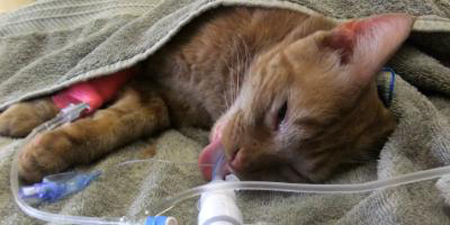- Navigation
- Home
- About
- » Meet Our Staff
- » Hospital Tour
- Services
- » Pet Wellness
- » Puppy and Kitten Care
- » Senior Pet Care
- » Pet Dental Care
- » Vaccinations
- » Microchip Implantation
- » Diagnostics Services
- » Pet Surgery
- » Pharmacy and Nutrition
- » Grooming
- » Boarding
- Resources
- » New Patient Info
- » Common Pet Health Issues
- » Canine Care Guide
- » Feline Care Guide
- » Pet Hospice and Euthanasia
- » Animal Rescue and Adoptions
- » Helpful Links
- News
- Contact
- » Schedule Appointment
- » Emergency
- » Request Prescription Refill
- Online Pharmacy
Pet Surgery
From spay and neuter services to more complex veterinary surgical procedures, we always operates with safety in mind.
In fact, we use many of the same safety measures as human hospitals. Performing most of the pre‐surgery blood work at our in-house lab, we are able to make sure your pet is healthy enough for the procedure.
Depending on the urgent nature of the surgery, pre‐surgical abnormalities will be addressed, drug selections may be modified and sometimes surgeries are postponed or even canceled until the surgical team feels the surgery is safe to perform.
Spaying
Spaying is a surgical procedure in which both ovaries and uterus are completely removed from your female pet. Also called an "ovariohysterectomy," the surgery is performed while your pet is under general anesthesia. There are many benefits to spaying your female companion. First, you will contribute to the prevention of the dog and cat overpopulation. Second, spaying will eliminate the sometimes 'messy' heat cycles that attract male dogs to your house from miles away. Third, you will help prevent diseases in your pet such as pyometra (infection in the uterus) and mammary cancer. Additionally, research has shown that pets that have been spayed live longer than pets that have not been spayed. We recommend spaying for all females ages 4-6 months.
Neutering
Neutering refers to the surgical procedure in which both testicles are removed. There are many benefits to neutering your male companion. First, you will contribute to the prevention of the dog and cat overpopulation. Second, neutering can help eliminate undesirable and at times, embarrassing behavior in your male companion. Third, you will help prevent diseases in your pet such as prostate disease and testicular cancer. We recommend neutering for all male pets by 6 months of age.
Anethesia
While there are many different levels of anesthesia, you can trust our veterinarians to make the appropriate recommendation for your pet. While under anesthesia, your pet is monitored using various methods, including:
- Doppler blood pressure
- EKG
- Oxygen/carbon dioxide levels
- Temperature regulation
- Constant human evaluation
Pain management
Pain management for all procedures is tailored to each patient based on pre- and post-surgical needs. Methods vary from pre-operative medications to post-operative IV infusions for 24-hour pain control. We may also recommend an at-home oral or topical pain medication.
Patient monitoring
Monitoring a patient under anesthesia is a complex undertaking and is extremely important to ensuring your pet’s health and safety. Our skilled and experienced staff closely observe a patient’s heart rate, blood flow, oxygenation levels, and respiratory functions. We also constantly monitor body temperature and employ effective warming protocols to avoid hypothermia, which can be a risk for anesthetized patients.
Call (205) 621-5755 to schedule an appointment
91 Weatherly Club Dr, Alabaster, AL 35007, info@weatherlyvets.com
Copyright © 2025 - Weatherly Animal Hospital

